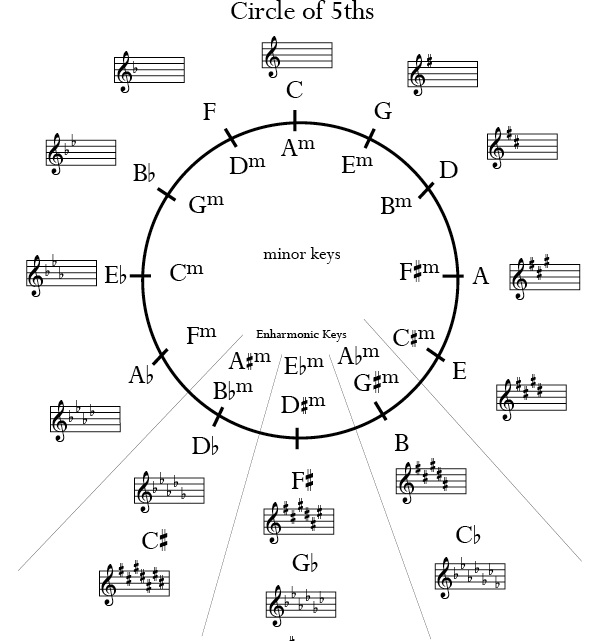
 |
|
#1
|
|||
|
|||
|
Hi, im posting this as i just realized (or seem to have realized) that the Circle of 5ths generates the Major Scale (in whatever root).
The first 6 notes in a circle of 5ths yield the I-VII degrees of a major scale, save for the IV degree, which comes out of the 12th note in the circle. I wonder what are the remaining 5 notes in the circle meant to do; namely, whether they are related to other scales than the major one, on one hand; and on the other, whether is there some point as to the fact that they precede the degree IV (which in its turn, splits the major scale into two identical parts). Any comment on the subject would be useful to me (excuse me for the rudimentary quality of my english  ). Greetings! ). Greetings!
Last edited by athair; 09-11-2013 at 11:17 AM. |
|
#2
|
|||
|
|||
 http://www.circle-of-fifths.net/ With time you'll move beyond the circle and think of the seven notes and related chords for each key that you want to use. Last edited by Bingoccc; 09-11-2013 at 11:57 AM. |
|
#3
|
|||
|
|||
|
Thank you for your reply!! Quite useful diagram!!! I´m going to stick at it!!
|
|
#4
|
|||
|
|||
|
Quote:
The more I know, the less I understand.." Paul Weller |
|
#5
|
|||
|
|||
|
"What do you mean, LJ?"
 ... ...
|
|
#6
|
|||
|
|||
|
Quote:
So it's not about reading off the letters and getting a scale - although you can certainly do that. The IV, btw comes from going back one step from I, not by continuing round to 12. I know it's the same result, but IMO going back one makes more sense. Think of the keynote as a "tonal centre". In piano notation, you find C in the middle, G (dominant) represented by the G clef above, F (subdominant) represented by the F clef below. Also think about the natural progression of chords when they move in a so-called "circle progression". The movement - like a gravitational pull - is from vii > iii > vi > ii > V > I (anticlockwise on the circle); I is where it comes to rest. The gravitational effect is more marked if you add 7ths to each chord. Moving on to IV means going away from the tonic again. IV can lead back round to vii, but essentially I is the kind of midway stable point between IV and V. Another nice trick you can do with the circle (check the above diagram) is find the six main chords in any one key. They're in one quarter segment of the circle. The tonic (I) is in the centre on the outside; the V chord is clockwise and the IV anticlockwise. Next to them on the inside are the three minor chords, ii, vi and iii. The vii chord is missing, but you really don't need that anyway!  (If you want it, you have to move one more step round the minor circle and make the chord diminished; not very neat!) (If you want it, you have to move one more step round the minor circle and make the chord diminished; not very neat!)Also, chords either side of this 6-chord block can often be brought in to expand the set of chords that sound good together. But the further you move away round the circle, the more distant or "alien" the chords sound to the home key.
__________________
"There is a crack in everything. That's how the light gets in." - Leonard Cohen. |
|
#7
|
|||
|
|||
|
I mean that I have been "playing" the guitar for about 40 years and this diagram means almost nothing to me...!
Music theory just scrambles what's left of my poor ol' brain. I just know that "If it's in the groove, everybody loves it!" (Howlin' Wolf) |
|
#8
|
|||
|
|||
|
Thanks a lot, Jon!! Your answer has quite interesting topics (namely, the second paragraph)!!
I wonder whether some degree of harmony theory could be (usefully, lets say) approached within the circle framework. For instance, in the sense of enabling one so as to deal with questions of the following sort (the questions i´m about to make had simply arised a couple of days ago, when trying to develop some stuff...for many, there might be altogether nonsensicall, i would concede anyway...): ¿would the circle fit into the diatonic/non diatonic issue when working within a given major scale? ¿would the circle fit into the issue of stating chromatic arrangements to embellish (perhaps, in weak tempos...) a given voice-progression within a given major scale? ...and so on... Thanks a lot (the mere fact of trying to make my mind clear becomes somewhat fruitful to me)!!! Greetings!!! JL, i agree with you in the sense that the diagram would hardly be of help as taken by itself...Thanks! Last edited by athair; 09-11-2013 at 01:33 PM. |